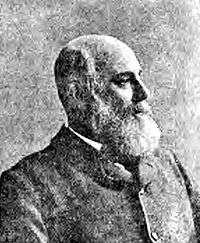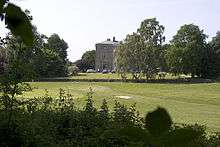Sir William Evans, 1st Baronet
Sir (Thomas) William Evans, 1st Baronet (15 April 1821 – 4 October 1892) was an English Liberal politician who represented the constituency of South Derbyshire.

Background and education
Evans was the son of William Evans of Allestree, Derby, who was an MP and High Sheriff, and his wife Mary Gisborne.[1] The Evans family had made a fortune from lead mines at Bonsall, and an iron slitting and rolling mill in Derby and a cotton mill at Darley Abbey.[2] They also owned the Evans Bank in Derby. However it was Evans' uncle, Samuel Evans, who ran the business. His own father, William Evans, had opted to take up the life of the landed gentleman at Allestree Hall.[3] Evans was educated at Trinity College, Cambridge.[4] Evans' father died in 1856 leaving him property including Pickford's House in Derby.[5]
Political career
Evans became Member of Parliament for Derbyshire South in 1857 and held the seat until 1868. He regained it in 1874 and held it until 1885. He stood unsuccessfully as the Liberal Unionist candidate for Derby.
He was a local philanthropist, being responsible for building a school in Parwich in 1861 and then rebuilding Parwich church in 1873. Evans continued to own the Evans Bank until it merged in 1877 with the older Derby-based Compton's Bank.[6] Evans was created a baronet of Allestree Hall on 18 July 1887.[7] He chaired the first meeting of the Derbyshire County Council on 1 April 1889 when the authority consisted of 60 councillors and 20 aldermen.[2] He was High Sheriff of Derbyshire in 1872,[8] and a Deputy Lieutenant, Justice of the Peace and Fellow of the Royal Geographical Society. As well as Allestree Hall, he owned the manor of Holbrooke,[9] the Parwich Hall estate and a house in Derby.[10]
Family

Evans married Mary Gisborne on 21 May 1846. She was the eldest daughter of Thomas John Gisborne of Holme Hall, Bakewell, Derbyshire. He was present when the Queen came to open the Derbyshire Royal Infirmary as he was the President of the new hospital.[11] On his death in Belper, in 1892, his baronetcy became extinct. He left his estate to William Gisborne.
References
- Burke Landed Gentry
- Derbyshire County Council
- The Evans dynasty, Derwent Valley Mills, accessed 19 August 2015
- "Evans, Thomas William (EVNS838TW)". A Cambridge Alumni Database. University of Cambridge.
- Craven, Maxwell (1983). The Derby Townhouse. breedon books. ISBN 0 907969 31 3.
- "Parwich Hall". Parwich & District Local History Society. September 2003. Retrieved 1 September 2015.
- "No. 25723". The London Gazette. 22 July 1887. p. 4001.
- "No. 23825". The London Gazette. 6 February 1872. p. 403.
- Holbrooke Derbs - Kelly's Directory 1891 Archived 12 August 2007 at the Wayback Machine
- Pickford's House Museum
- Permanent Record of Queen Victoria's State Visit to Derby. Market Place, Derby: W.Hobson. 1891.
External links
- Hansard 1803–2005: contributions in Parliament by Sir William Evans, Bt
| Parliament of the United Kingdom | ||
|---|---|---|
| Preceded by William Mundy (Markeaton) Charles Robert Colvile |
Member of Parliament for South Derbyshire 1857–1868 With: Charles Robert Colvile 1857–1859 William Mundy (Markeaton) 1859–1865 Charles Robert Colvile 1865–1868 |
Succeeded by Rowland Smith Sit Thomas Gresley |
| Preceded by Rowland Smith Sir Henry Wilmot |
Member of Parliament for South Derbyshire 1874–1885 With: Sir Henry Wilmot |
Succeeded by Henry Wardle (representation reduced to one member 1885) |
| Honorary titles | ||
| Preceded by Charles Rowland Palmer Morewood |
High Sheriff of Derbyshire 1872–1873 |
Succeeded by John Gilbert Crompton |
| Baronetage of the United Kingdom | ||
| New creation | Baronet (of Allestree) 1887–1892 |
Extinct |